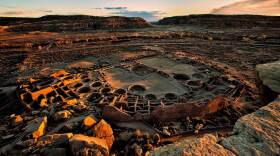Navajo Nation lawmakers may have thrown a wrinkle into efforts aimed at establishing a permanent buffer around Chaco Culture National Historical Park, as New Mexico’s congressional delegation, environmentalists and other tribes try to keep oil and gas development from getting closer to the World Heritage site.
Navajo Nation delegates voted Thursday to support a buffer only half the size of the one outlined in federal legislation pending in Congress. They cited concerns from Navajo landowners who fear their mineral rights would be landlocked and the money they earn through lease payments and royalties compromised if future development is prohibited across a wider swath of land surrounding the national park.
Supporters of the measure approved by the tribal delegates argue that a smaller 5-mile buffer would protect the economic interests of Navajo landowners. New Mexico’s congressional delegation says considerable time was spent drafting the legislation and that they worked with Navajo leaders and members of the All Pueblo Council of Governors, an organization that represents other sovereign tribes around New Mexico.
The Navajo vote comes despite support from the pueblos, Navajo President Jonathan Nez and some individual Navajo communities for the more expansive protective zone. It highlights the polarity that has long existed within the Navajo Nation’s branches of government and with other tribes. Nez said Friday he believed the tribe was unified on the 10-mile buffer and that much of the discussion in the council was one-sided. The vote, he said, could affect movement of the bills in Congress.
The measure’s sponsor, Mark Freeland, told fellow lawmakers Thursday that various Navajo departments and the lawmakers weren’t consulted on the creation of the federal legislation. Landowners who are concerned about their ability to lease their land for drilling weren’t given time to speak with members of Congress who visited Chaco last year either, he said. The measure also included a request for updated maps, the number of landowners in the 5-mile and 10-mile buffer zone, and more consultation with the Navajo Nation.
Nez said he, too, would welcome a visit from U.S. senators to the Navajo Nation as they consider the federal legislation.
Chaco Culture National Historical Park is at the center of a decades-long debate over how to manage oil and gas development in a sprawling area of northwestern New Mexico that is dotted by sites tied to the park but that lie outside its boundaries.
The U.S. House in December approved legislation prohibiting drilling on the checkerboard of federal land that borders the park. The measure also calls for terminating existing non-producing leases in the area and suggests more studies and protective measures be taken to address health, safety and environmental effects on communities and tribal interests.
Similar legislation is pending in the Senate.




